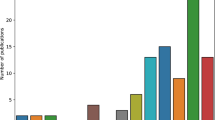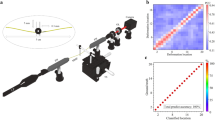Abstract
Bending estimation is an important property that must be assessed in several engineering applications including structural health monitoring, aerospace, robotics, geophysics, etc. While strain gauges and accelerometers are used to estimate bending behavior based on Machine-Learning (ML), few works in the literature have focused on the estimation of the magnitude of bending by combining ML techniques and fiber optic sensors. In this work, an ML-based method for estimating bending magnitude using the signal generated by an optical fiber sensor is presented. The sensor is formed by splicing a single-mode fiber with a multimode fiber. The interferogram generated from the sensor is processed to create a set of signal feature vectors (FVs). Thus, for estimating the bending magnitude, these FVs are used to train Machine-learning algorithms including Support Vector Machine, K-Nearest Neighbors, Naive Bayes, and Random Forest. To evaluate how each ML model performs, the accuracy, precision, recall, and \(F_1\)-score metrics are used. The best performance is obtained by the Random Forest algorithm with a classification accuracy of 100%.
Access this chapter
Tax calculation will be finalised at checkout
Purchases are for personal use only
Similar content being viewed by others
References
Ogundare, J.O.: Precision surveying: the principles and geomatics practice. John Wiley & Sons (2015)
Kersey, A., et al.: Fiber grating sensors. J. Lightwave Technol. 15(8), 1442–1463 (1997)
Lee, B.H.: Interferometric fiber optic sensors. Sensors 12(3), 2467–2486 (2012). https://www.mdpi.com/1424-8220/12/3/2467
Ciȩszczyk, S., Kisała, P.: Inverse problem of determining periodic surface profile oscillation defects of steel materials with a fiber bragg grating sensor. Appl. Opt. 55(6), 1412–1420 (2016). https://opg.optica.org/ao/abstract.cfm?URI=ao-55-6-1412
Voulodimos, A., Doulamis, N., Bebis, G., Stathaki, T.: Recent developments in deep learning for engineering applications. Computational Intell. Neurosc. (2018)
Pasupa, K., Sunhem, W.: A comparison between shallow and deep architecture classifiers on small dataset. In: 2016 8th International Conference on Information Technology and Electrical Engineering (ICITEE), pp. 1–6 (2016)
Pham, C.C., Jeon, J.W.: Robust object proposals re-ranking for object detection in autonomous driving using convolutional neural networks. Signal Proces. Image Commun. 53, 110–122, (2017). https://www.sciencedirect.com/science/article/pii/S0923596517300231
Li, S., Deng, M., Lee, J., Sinha, A., Barbastathis, G.: Imaging through glass diffusers using densely connected convolutional networks. Optica, 5(7), 803–813 (2018). https://opg.optica.org/optica/abstract.cfm?URI=optica-5-7-803
Aisawa, S., Noguchi, K., Matsumoto, T.: Remote image classification through multimode optical fiber using a neural network. Opt. Lett. 16(9), 645–647 (1991). https://opg.optica.org/ol/abstract.cfm?URI=ol-16-9-645
Lohani, S., Knutson, E.M., O’Donnell, M., Huver, S.D., Glasser, R.T.: On the use of deep neural networks in optical communications. Appl. Opt. 57(15), 4180–4190 (2018). https://opg.optica.org/ao/abstract.cfm?URI=ao-57-15-4180
Rivenson, Y., et al.: Deep learning microscopy. Optica 4(11), 1437–1443 (2017). https://opg.optica.org/optica/abstract.cfm?URI=optica-4-11-1437
Nehme, E., Weiss, L.E., Michaeli, T., Shechtman, Y.: Deep-storm: super-resolution single-molecule microscopy by deep learning. Optica 5(4), 458–464 (2018). https://opg.optica.org/optica/abstract.cfm?URI=optica-5-4-458
Corsi, A., Chang, J.H., Wang, R., Wang, L., Rusch, L.A., LaRochelle, S.: Highly elliptical core fiber with stress-induced birefringence for mode multiplexing. Opt. Lett. 45(10), 2822–2825 (2020). https://opg.optica.org/ol/abstract.cfm?URI=ol-45-10-2822
Jakkula, V.: Tutorial on support vector machine (svm), School of EECS, vol. 37(2.5), p. 3. Washington State University (2006)
Sun, S., Huang, R.: An adaptive k-nearest neighbor algorithm. In: 2010 Seventh International Conference on Fuzzy Systems and Knowledge Discovery, vol. 1, pp. 91–94 IEEE (2010)
Nir Friedman, M.G., Geiger, D.: Bayesian network classifiers. Mach. Learn. 29, 131–163 (1997)
Leo, B.: Random forests. Mach. Learn. 45, 5–32 (2001)
Sokolova, M., Lapalme, G.: A systematic analysis of performance measures for classification tasks. Information Process. Manag. 45(4), 427–437 (2009)
Wong, T.-T., Yeh, P.-Y.: Reliable accuracy estimates from k-fold cross validation. IEEE Trans. Knowl. Data Eng. 32(8), 1586–1594 (2019)
Author information
Authors and Affiliations
Corresponding author
Editor information
Editors and Affiliations
Rights and permissions
Copyright information
© 2023 The Author(s), under exclusive license to Springer Nature Switzerland AG
About this paper
Cite this paper
Valentín-Coronado, L.M., Martínez-Manuel, R., Esquivel-Hernández, J., LaRochelle, S. (2023). Machine-Learning Based Estimation of the Bending Magnitude Sensed by a Fiber Optic Device. In: Rodríguez-González, A.Y., Pérez-Espinosa, H., Martínez-Trinidad, J.F., Carrasco-Ochoa, J.A., Olvera-López, J.A. (eds) Pattern Recognition. MCPR 2023. Lecture Notes in Computer Science, vol 13902. Springer, Cham. https://doi.org/10.1007/978-3-031-33783-3_29
Download citation
DOI: https://doi.org/10.1007/978-3-031-33783-3_29
Published:
Publisher Name: Springer, Cham
Print ISBN: 978-3-031-33782-6
Online ISBN: 978-3-031-33783-3
eBook Packages: Computer ScienceComputer Science (R0)





